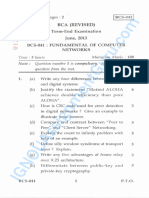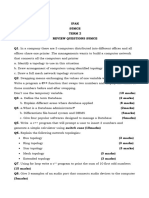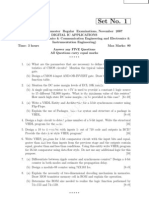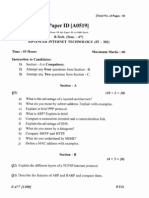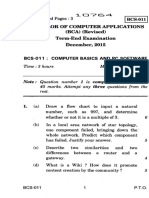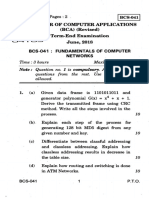0 ratings0% found this document useful (0 votes)
12 viewsA. Discuss The Operation and Benefits of Ipv6 B. Describe The Structure of The Ipv4 Header in
A. Discuss The Operation and Benefits of Ipv6 B. Describe The Structure of The Ipv4 Header in
Uploaded by
Abhishek VaishCopyright:
© All Rights Reserved
Available Formats
Download as DOC, PDF, TXT or read online from Scribd
A. Discuss The Operation and Benefits of Ipv6 B. Describe The Structure of The Ipv4 Header in
A. Discuss The Operation and Benefits of Ipv6 B. Describe The Structure of The Ipv4 Header in
Uploaded by
Abhishek Vaish0 ratings0% found this document useful (0 votes)
12 views1 pageOriginal Title
cn
Copyright
© © All Rights Reserved
Available Formats
DOC, PDF, TXT or read online from Scribd
Share this document
Did you find this document useful?
Is this content inappropriate?
Copyright:
© All Rights Reserved
Available Formats
Download as DOC, PDF, TXT or read online from Scribd
Download as doc, pdf, or txt
0 ratings0% found this document useful (0 votes)
12 views1 pageA. Discuss The Operation and Benefits of Ipv6 B. Describe The Structure of The Ipv4 Header in
A. Discuss The Operation and Benefits of Ipv6 B. Describe The Structure of The Ipv4 Header in
Uploaded by
Abhishek VaishCopyright:
© All Rights Reserved
Available Formats
Download as DOC, PDF, TXT or read online from Scribd
Download as doc, pdf, or txt
You are on page 1of 1
(Following Paper code & Roll No, To be filled in your answer book)
e. Discuss various Error detecting and correcting
PAPER Code- KCS-603 Roll No.
methods
BBS College of Engineering & Technology
2nd Sessional (2023-2024) (Section C)
Branch: CS Sem: 5th
Subject: Computer Networks Q3. Attempt any two of the following: (5x2=10)
Max Marks: 30 MaxTime: 1:30 hr.
Note: 1. The Question paper contains three parts. a. Discuss the operation and benefits of IPv6
2. All questions are compulsory. compared to IPv4.
(Section A)
b. Describe the structure of the IPv4 header in
detail, including the purpose and size of each
Q1. Write a short note on any four of the following: field.
(4x2=8)
a. How is the generator polynomial selected in CRC? c. How would you perform CRC encoding using
b. Define framing in the context of data link layer polynomial division for the message "110101"
protocols. with the generator polynomial 𝐺 ( 𝑥 ) = 𝑥 3 + 𝑥
c. What is the main function of the Medium Access + 1 G(x)=x 3 +x+1? Show your step-by-step
Control (MAC) layer in the OSI model?
process and provide the encoded message
d. What is the purpose of ARP (Address Resolution
Protocol) in a network?
e. What is the main function of UDP (User Datagram
Protocol) in the transport layer?
(Section B)
Q2. Attempt any four of the following: (4x3=12)
a. Compare and contrast the basic operation of TCP
and UDP in the transport layer.
b. Explain the significance of CIDR (Classless Inter-
Domain Routing) in modern networking.
c. Discuss the role of link layer switches in
improving network performance.
d. Discuss the CSMA protocols.?
You might also like
- World Papercraft Buildings of The World Series England (Section 1)Document5 pagesWorld Papercraft Buildings of The World Series England (Section 1)GregNo ratings yet
- CAF206 - Computer NetworksDocument2 pagesCAF206 - Computer NetworkskhushalcloudNo ratings yet
- 22634-Sample-Question-Paper (Msbte Study Resources)Document4 pages22634-Sample-Question-Paper (Msbte Study Resources)RaashidNo ratings yet
- Scheme - I Sample Test Paper - IDocument4 pagesScheme - I Sample Test Paper - Ineha chauguleNo ratings yet
- Cao Previous QNDocument9 pagesCao Previous QNanusha deviNo ratings yet
- 2011 Apr Cert CNTDocument4 pages2011 Apr Cert CNTmichaelmikealNo ratings yet
- Campusexpress - Co.in: Set No. 1Document8 pagesCampusexpress - Co.in: Set No. 1skssushNo ratings yet
- BCS-041 June2010-June2023 IGNOUAssignmentGuru - Com 044245Document63 pagesBCS-041 June2010-June2023 IGNOUAssignmentGuru - Com 044245vivek sharmaNo ratings yet
- 2011 Advanced Computer Architecture: CS/B.TECH (CSE) /SEM-4/CS-403/2011Document7 pages2011 Advanced Computer Architecture: CS/B.TECH (CSE) /SEM-4/CS-403/2011Avik MitraNo ratings yet
- Review Questions S5mceDocument7 pagesReview Questions S5mcegostzendaNo ratings yet
- Mar 17-Cert-CntDocument4 pagesMar 17-Cert-CntmichaelmikealNo ratings yet
- Computer Science S5 Deistric ExamDocument4 pagesComputer Science S5 Deistric Examashrafsmith272No ratings yet
- Digital Nov 07Document6 pagesDigital Nov 07skssushNo ratings yet
- Examination Question Paper: Examination Answer Booklet Supplementary Sheets, As Detailed BelowDocument3 pagesExamination Question Paper: Examination Answer Booklet Supplementary Sheets, As Detailed BelowAnonymous 1XKFHpNo ratings yet
- NR-320502 Computer NetworksDocument6 pagesNR-320502 Computer NetworksSrinivasa Rao G100% (2)
- MCS-218 Ignouassignmentguru - Com519Document11 pagesMCS-218 Ignouassignmentguru - Com519नितिन पटवालNo ratings yet
- HT TP: //qpa Pe R.W But .Ac .In: 2013 Advanced Computer ArchitectureDocument4 pagesHT TP: //qpa Pe R.W But .Ac .In: 2013 Advanced Computer ArchitectureSatanu MaityNo ratings yet
- 7th ITDocument6 pages7th ITYashika JindalNo ratings yet
- Switching Theory and Logic Design - June-2015Document55 pagesSwitching Theory and Logic Design - June-2015Rama HarithaNo ratings yet
- IT1020 - Introduction To Computer SystemsDocument6 pagesIT1020 - Introduction To Computer SystemsgepoveNo ratings yet
- 2013 Computer Architecture: CS/B.Tech/CSE/NEW/SEM-4/CS-403/2013Document7 pages2013 Computer Architecture: CS/B.Tech/CSE/NEW/SEM-4/CS-403/2013Avik MitraNo ratings yet
- BCS 041 Previous Year Question Papers by IgnouassignmentguruDocument45 pagesBCS 041 Previous Year Question Papers by IgnouassignmentguruaddNo ratings yet
- Sample Question Paper Data CommunicationDocument5 pagesSample Question Paper Data CommunicationYash Hartalkar0% (1)
- Mse Prev Year (2025)Document9 pagesMse Prev Year (2025)thisistherobbaryNo ratings yet
- Computer NetworkDocument5 pagesComputer Networkkuvarjigupta2004No ratings yet
- BCA_I_YEARDocument7 pagesBCA_I_YEARNavneet sharmaNo ratings yet
- Computer Network Ncs 601 2017Document1 pageComputer Network Ncs 601 2017rahul112001mauryaNo ratings yet
- CMSG-I B.Sc. General PART-I Examinations, 2018Document2 pagesCMSG-I B.Sc. General PART-I Examinations, 2018Sumit HalderNo ratings yet
- MCS 042 Previous Year Question Papers by IgnouassignmentguruDocument58 pagesMCS 042 Previous Year Question Papers by IgnouassignmentguruAbhi kumarNo ratings yet
- Sum23 PDFDocument2 pagesSum23 PDFNikita PatilNo ratings yet
- BCS 041Document16 pagesBCS 041Mr. Janardhana V ECENo ratings yet
- MCS-218 AllDocument17 pagesMCS-218 Allxitere5524No ratings yet
- Computer Network 2021Document2 pagesComputer Network 2021manoj kumarNo ratings yet
- Data Communication and Computer NetworkDocument4 pagesData Communication and Computer NetworkHemanshuNo ratings yet
- COA KCS-302 Model Question Paper: Computer Organization & Architecture (Dr. A.P.J. Abdul Kalam Technical University)Document3 pagesCOA KCS-302 Model Question Paper: Computer Organization & Architecture (Dr. A.P.J. Abdul Kalam Technical University)Piyush GuptaNo ratings yet
- Sem 5 - Comps, Iot, Cyber, Cs - Computer Network - 2024 May To 2022 Dec Pyq - Aeraxia - inDocument5 pagesSem 5 - Comps, Iot, Cyber, Cs - Computer Network - 2024 May To 2022 Dec Pyq - Aeraxia - inmendezerjsonNo ratings yet
- It6 Ait Dec08Document2 pagesIt6 Ait Dec08Surjeet MarwahNo ratings yet
- CSE 425 Fall Midterm 2020 AssessmentDocument1 pageCSE 425 Fall Midterm 2020 AssessmentMd.Rakibul IslamNo ratings yet
- CS 3203 CN End-Sem-SET2Document3 pagesCS 3203 CN End-Sem-SET2pluscommander972No ratings yet
- CMSG-I B.Sc. General PART-I Examinations, 2017Document4 pagesCMSG-I B.Sc. General PART-I Examinations, 2017Sumit HalderNo ratings yet
- 3 Hours / 70 Marks: Seat NoDocument3 pages3 Hours / 70 Marks: Seat No916. Saee YadavNo ratings yet
- Pdfjoiner PDFDocument26 pagesPdfjoiner PDFbakosey323No ratings yet
- ENSC427 Final 1231Document4 pagesENSC427 Final 1231477889997mNo ratings yet
- MCSE-011 - D16 - CompressedDocument4 pagesMCSE-011 - D16 - CompressedDeepthireddyNo ratings yet
- Sample Question Paper Digital Communication SystemsDocument4 pagesSample Question Paper Digital Communication Systemspawan_32No ratings yet
- Bscit 101Document2 pagesBscit 101api-3782519No ratings yet
- 2020 09 14SupplementaryCS405CS405 D Ktu QbankDocument3 pages2020 09 14SupplementaryCS405CS405 D Ktu QbankCigi ManojNo ratings yet
- Computer NetworkDocument8 pagesComputer NetworkAparna PandeyNo ratings yet
- Sessional 1-1Document5 pagesSessional 1-1AnubhavNo ratings yet
- CS-68 Bachelor in Computer Applications Term-End Examination June, 2012 Cs-68: Computer NetworksDocument2 pagesCS-68 Bachelor in Computer Applications Term-End Examination June, 2012 Cs-68: Computer Networksr_k_sNo ratings yet
- EC206 CO Modelqn2 Ktustudents - inDocument3 pagesEC206 CO Modelqn2 Ktustudents - ingpuonlineNo ratings yet
- CN 1Document2 pagesCN 1u2203162No ratings yet
- M. Tech. Semester - I: Advanced Computer Architecture (MCSCS102IBMCSCS 902)Document12 pagesM. Tech. Semester - I: Advanced Computer Architecture (MCSCS102IBMCSCS 902)saurabh1116No ratings yet
- Instructions To Candidates: The Candidates Should Answer The Questions in EnglishDocument3 pagesInstructions To Candidates: The Candidates Should Answer The Questions in Englishkamauellam04No ratings yet
- SIT202 Problem Solving Report 1Document5 pagesSIT202 Problem Solving Report 1Rakesh KumarNo ratings yet
- Time: 3 Hours Maximum Marks: 100 (Weightage: 75%) Question Number Is and Carries 40 Marks. Attempt Any Questions From The RestDocument3 pagesTime: 3 Hours Maximum Marks: 100 (Weightage: 75%) Question Number Is and Carries 40 Marks. Attempt Any Questions From The RestAbhijeetNo ratings yet
- BEET 404 Computer Org. ArchitectureDocument2 pagesBEET 404 Computer Org. Architecturesashishere107No ratings yet
- BCS 041 PDFDocument2 pagesBCS 041 PDFSalma nanNo ratings yet
- Sem3 QuestionDocument8 pagesSem3 QuestionatifkhanonwebNo ratings yet
- SEM 5, SESSIONAL 1 23-24 CseDocument4 pagesSEM 5, SESSIONAL 1 23-24 Cse『Devendra Singh Meena』No ratings yet
- Product Manual 03109 (Revision NEW) : 3161 GovernorDocument20 pagesProduct Manual 03109 (Revision NEW) : 3161 GovernorHelen BachtiarNo ratings yet
- New 8fbn 15 30tDocument7 pagesNew 8fbn 15 30tLực NguyễnNo ratings yet
- Gondär in The Early Twentieth Century - A Preliminary Investigation of A 1930 - 31 CensusDocument26 pagesGondär in The Early Twentieth Century - A Preliminary Investigation of A 1930 - 31 CensusAchamyeleh TamiruNo ratings yet
- CV Europass 20181121 RadmanFunarić HR 21.11.2018.Document10 pagesCV Europass 20181121 RadmanFunarić HR 21.11.2018.Veleučilište u PožegiNo ratings yet
- BOT Tender TMCDocument139 pagesBOT Tender TMCrohit100% (1)
- GrenTech Express Communication System Introduction 1.0Document30 pagesGrenTech Express Communication System Introduction 1.0Son NguyenNo ratings yet
- f5 2010 Jun Q PDFDocument8 pagesf5 2010 Jun Q PDFcatcat1122No ratings yet
- A.K. International - Price List 2011Document4 pagesA.K. International - Price List 2011pvrk_78No ratings yet
- Search Video Use Url 2 ConnectionDocument95 pagesSearch Video Use Url 2 Connectionfrancovalle122No ratings yet
- Yeastar TA1600&TA2400&TA3200 User Manual enDocument60 pagesYeastar TA1600&TA2400&TA3200 User Manual enMichał SzargaNo ratings yet
- Papers 24Document4 pagesPapers 24tyagim674674No ratings yet
- Mick Hyde: 2006 Radical SR4 Owners Manual - Doc - Issue 1 - 1 - 27/03/06Document11 pagesMick Hyde: 2006 Radical SR4 Owners Manual - Doc - Issue 1 - 1 - 27/03/06torstenstephant-online.deNo ratings yet
- Machine Learning Based Spam E-Mail DetectionDocument10 pagesMachine Learning Based Spam E-Mail Detectionghazy almutiryNo ratings yet
- Pyopenssl Documentation: Release 20.0.0.devDocument61 pagesPyopenssl Documentation: Release 20.0.0.devsaothiencodenNo ratings yet
- PWC-S04-SS03-Fuel Tank and Fuel Pump - Shop Manual - 4-TEC - Version 2AA - ENDocument24 pagesPWC-S04-SS03-Fuel Tank and Fuel Pump - Shop Manual - 4-TEC - Version 2AA - ENAlexander AbregoNo ratings yet
- Tips For Parents of VegansDocument2 pagesTips For Parents of VegansVegan FutureNo ratings yet
- Individual or Joint Specimen Signature Card 07-31-2014Document1 pageIndividual or Joint Specimen Signature Card 07-31-2014Dialife Medical Equipment and SuppliesNo ratings yet
- Reactive Dyeing of CottonDocument61 pagesReactive Dyeing of CottonTuan Nguyen Minh100% (3)
- Strategic Supply Chain Management The Development of A Diagnostic ModelDocument277 pagesStrategic Supply Chain Management The Development of A Diagnostic ModelKumar SaurabhNo ratings yet
- Gokongwei Vs SECDocument18 pagesGokongwei Vs SECAnonymous PYorid9ANo ratings yet
- FusionServer 2288H V7 Server Technical White PaperDocument174 pagesFusionServer 2288H V7 Server Technical White Papereduardo arturo zaldivarNo ratings yet
- Blyth Inserts A4Document16 pagesBlyth Inserts A4albano pereiraNo ratings yet
- Pinterest Planner: The UltimateDocument18 pagesPinterest Planner: The UltimateDee100% (1)
- 2a LM6000 DLE EvolutionDocument30 pages2a LM6000 DLE EvolutionanasNo ratings yet
- World Is Flat Thomas FriedmanDocument10 pagesWorld Is Flat Thomas FriedmanGilean DalidaNo ratings yet
- Itex ReportDocument12 pagesItex ReportM HammadNo ratings yet
- Uflex Packaging StartegyDocument91 pagesUflex Packaging StartegyRahul Jamdagni100% (1)
- DS 85 Operators MTXDocument32 pagesDS 85 Operators MTXVenkatraman KrishnanNo ratings yet
- Saint Aquinas and Mercantilism School of ThoughtsDocument11 pagesSaint Aquinas and Mercantilism School of ThoughtsKatunga MwiyaNo ratings yet







